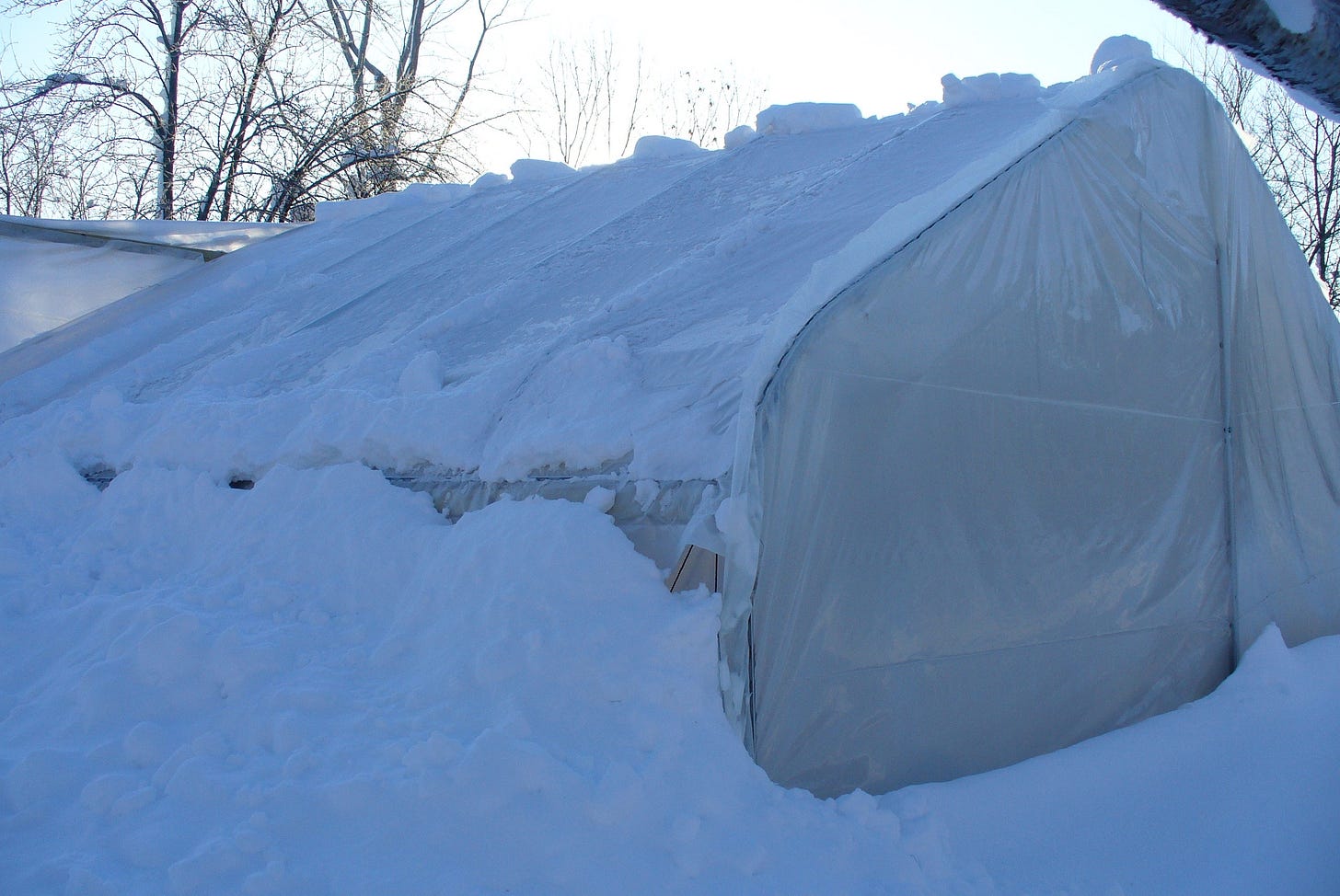I built my third, and biggest, hoop house, or high tunnel, this fall, which is why you didn’t see any articles from me then. I planted my first crop, Russian kale, before the endwalls were on, which was promptly destroyed by rabbits when I left a gate open. But despite an inauspicious start, I think it’s going to be a success.
A hoop house is your own little microclimate, moving you a couple of plant hardiness zones south. In Zone 4, where I live, that adds up. That’s like moving from the Lake Superior shore, where I now live, to central Illinois, where I grew up, 500 miles south, or even further, and without all the heat and humidity. But used anywhere you have seasons, it will expand your gardening year.
A greenhouse of any sort is not strictly necessary in growing all your own food. Unless you live in the arctic, you can find a way to produce a sufficient and varied diet without it. Traditionally, growers in a short season climate like the one I live in, where our frost-free season is only from early June to mid-September, produced cold tolerant crops like oats and other small grains, potatoes, cabbage family vegetables, and hay for beef and dairy cattle. That’s an adequate food supply. Root cellaring, canning, drying, and freezing kept those vegetables year round. So don’t feel like you can’t grow enough without a hoop house. We have tomatoes year round canned or dried, though our fresh tomato season last year was maybe only a month long outdoors.
In terms of priorities, a hoop house comes well after getting a productive outdoor garden rolling. I think it comes after chickens as well, unless you plan to house your chickens in the hoop. For me, it was also after getting a cattle herd started.
Personally, the value of a hoop house comes down to earlier salads, a longer fresh tomato season, more cucumbers, and winter spinach. I can get by without those, but who wants to? It also spreads out our workload, giving us more time in which to can tomatoes and make pickles, and reduces our need for freezing vegetables.
Unlike a traditional greenhouse, a hoop house is usually not heated, and usually doesn’t have rigid glazing, like glass or polycarbonate. Heating becomes tremendously expensive and is not needed unless you are really growing out-of-season crops, like cucumbers or tomatoes all winter. The idea is more to extend the seasons than to totally defy them. You can start your tomatoes or cucumbers earlier, get more production mid-season, and harvest later into the fall in a hoop house, usually without added heat. Rigid glazing is much more expensive, and though more durable, most people use plastic
And, in truth, you wouldn’t get much growth over the winter even if you heated it to tropical temperatures, because the sunlight is just not there in the north. Overwintered crops put on their growth in the fall and essentially sit in cold storage over winter. A tight hoop house can really warm up on a sunny winter day. Mine was recently at 45º F on a bright 12° February day. Going into spring, the temperature differential gets even bigger as the sun gets stronger. But the real benefits, besides warmer days, are more moderate nighttime temperatures and protection from wind, snow and ice. Kale, for instance, will overwinter outside, but is prone to what looks like freezer burn and becomes a real pain to dig out of the snow. It lasts much better in a protected hoop house. Soil in a hoop house freezes in northern Wisconsin but not in southern Wisconsin.
Typically, I’ll manure and till the soil in my hoop in the fall if I can. Then, in March or April, depending on the weather, I’ll plant salad crops, like Asian greens and spinach. Lettuce is a little more delicate than the others, so I’ll plant it a little later. I’ll also plant peas, carrots, and cooking greens, such as collards, kale, or mustards. Exactly when depends on your climate, and, like so many things, involves some trial and error. But seed is cheap compared to the value of produce, so experiment to see what works in your area.
Keep reading with a 7-day free trial
Subscribe to UnCowed to keep reading this post and get 7 days of free access to the full post archives.






